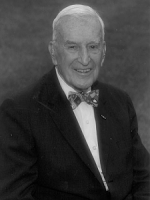Lauriston Sale Taylor

Affiliation
Country
USA
Lauriston Taylor (1902 – 2004) was born in Brooklyn, USA on June 1, 1902, and graduated from Cornell University with a Degree in Physic is in 1926. He received honorary doctorates from University of Pennsylvania (1960) and St. Procopius College (1965).
Laurie (as he was called by friends and colleagues) started his career at the National Bureau of Standards (NBS), which is now known as National Institute of Standards and Technology (NIST), and in 1951 he became chief of the Atomic and Radiation Physics Division. His research here focused on ionising radiation and radiological protection standards. Taylor developed the guarded field standard ionisation chamber and studied radiation measurement and protection, ionisation of liquids, and variable oscillators. After leaving the NBS, Taylor served the National Academy of Sciences (NAS), Washington, D.C., as Special Assistant to the President and Executive Director of the Academy’s Advisory Committee to the Office of Emergency Preparedness, where he remained until 1972. In addition to careers at the NBS and NAS, Taylor was also the founder and President of the National Council on Radiation Protection and Measurements (NCRP), for which he served as President from 1929 until his retirement in 1977.
Taylor had an enormous impact on ICRP. He was present at the very first meeting of the ICRP forerunners, the International X-ray and Radium Protection Committee (IXRPC) in 1928 and served as a member of ICRP in various positions from 1928-1993, an astounding 65 years. During his career, he was involved in no fewer than 75 committees of 37 different organizations of amazing diversity, including the American Medical Association, the Atomic Energy Commission, the Civil Service Commission, and the International Labor Organization, as well as scientific peer-review committees at various institutions including Argonne National Laboratory, where he served an unprecedented three times. He belonged to 16 scientific societies and served as president of two. He also authored over 160 scientific papers and wrote or contributed to twenty books, including Organization for Radiation Protection (Taylor 1979), and testified as an expert witness in several court cases related to radiation exposure. In short, Taylor is best known for helping establish the first national standard for x-ray exposure and for his contributions to radiological protection guidelines.
Since 1929, Taylor received at least 25 other honors ranging from the Gold Medal of the XIIIth International Congress of Radiology, the Gold Medal of the Royal Swedish Academy of Sciences (1992), the Gold Medal of the American Roentgen Ray Society to the Distinguished Service Award, Executive Office of the President, and many others. He received 17 letters of commendation, most of them during his service with the Air Force. In the field of radiological protection, he was considered the "man for all seasons" and second to none. His legacy will live for generations to come.
In addition to his many professional achievements, Taylor was also a licensed plumber, electrician, and carpenter and a master at woodwork. These skills he put to good use throughout his life. He enjoyed hiking and camping along the Appalachian Trail with his sons.
REFERENCES:
Taylor, N.W., Sinclair, W.K., Gorson, R.O. In Memoriam: Lauriston S. Taylor (1902-2004). Health Physics Society. http://hps.org/aboutthesociety/people/inmemoriam/lauristontaylor.html# (accessed on 2023 February 10)
Taylor, Lauriston S. (Lauriston Sale), 1902-2004. Social Networks and Archival Content. http://n2t.net/ark:/99166/w6pr7x7k (accessed on 2023 February 10)
Taylor, L.S., 1979. Organization for Radiation Protection: the Operations of the ICRP and NCRP 1928–1974. DoE/TIC 10124. US Department of Energy, Washington, DC.